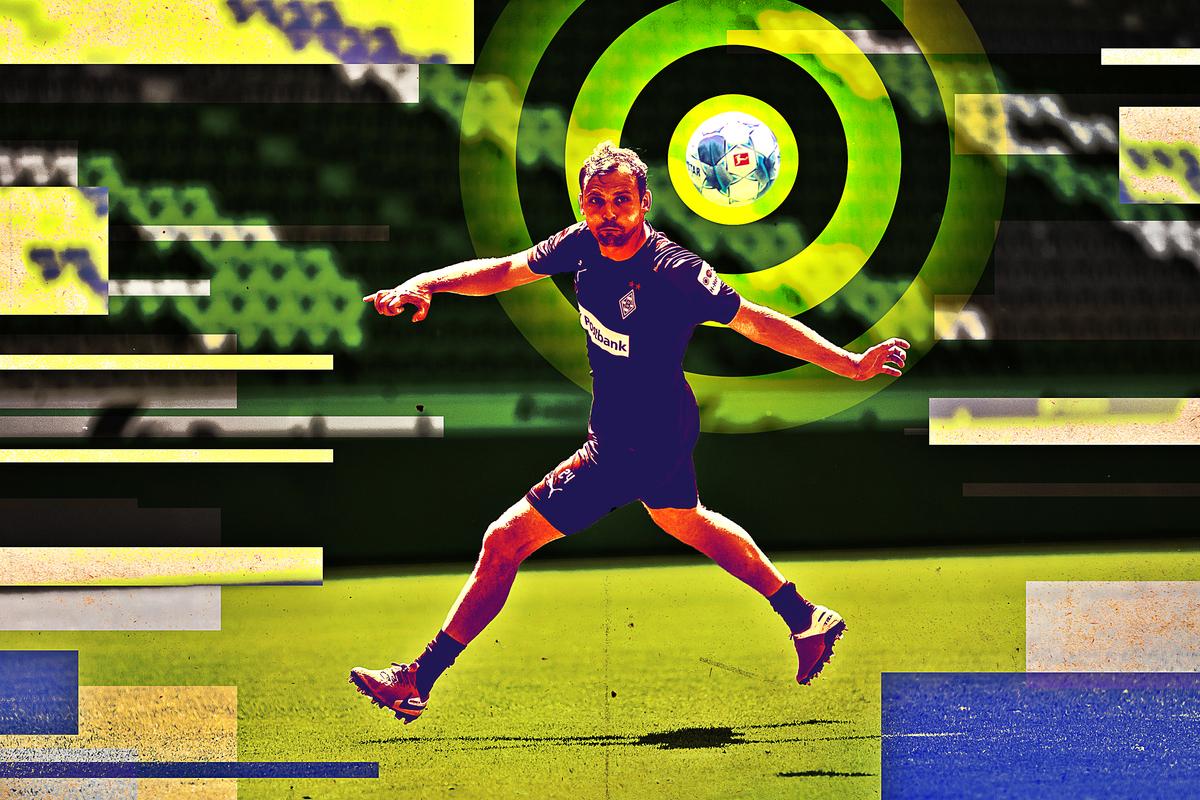
As humiliating clapbacks from reality go, the recent quarantining of the entire Dynamo Dresden soccer team probably doesn’t rise to the level of a COVID-19 outbreak inside the White House, but it’s still not a great look. I just plugged “shitty optics” into German Google Translate and got back Shitty-Optik, which feels wrong, but let’s go with it: Two Dresden players testing positive for the virus just a few days before play is set to resume in the top two tiers of German Fußball is a case of Shitty-Optik noteworthy even in a pandemic season not exactly hurting for bitter ironies. It’s Shitty-Optik almost on the order of Amazon’s stock price soaring 300 points during a month when 20 million Americans lost their jobs, if maybe marginally less consequential for humanity.
The reopening of the Bundesliga this weekend was supposed to be a triumph, a visible emblem of the success of Germany’s rational and effective approach to limiting the spread of the coronavirus. The lesson was supposed to be that countries with well-managed public-health programs get to have sports. This is why sports-starved Americans are waking up at 4 a.m. to watch Taiwanese baseball while the NBA tries to work out the logistics of staging the playoffs from a sealed bunker five miles under Disney World. The Bundesliga might still symbolize that lesson, but it will have to do so without Dresden, a second-division club whose players are now stuck at home for two weeks and facing a crowded match schedule if and when they’re able to come back. And this is before the restart has even restarted. Once play actually kicks off on Saturday, will the rest of the season pass without further positive tests, which would lead to further quarantine orders, to scheduling headaches, to matches involving players who haven’t been able to practice for weeks, etc.? I would go back to Google Translate here, but I already know the German word for “no.”
What’s frustrating about this is that Germany’s response to the pandemic really has looked exemplary, and the plan to reopen the Bundesliga really does seem well thought through. As of May 10, only 7,369 Germans were reported to have died from the virus—and yes, I know, “only,” but compare that number to the 32,000 deaths in the United Kingdom, which has a smaller population, or to the nearly 80,000 deaths in the U.S., where COVID-19 continues to kill well over a thousand people almost every day. I live in a town of 18,000, so I reflexively translate virus statistics into multiples and fractions of that number. In Germany, not quite half of my town has died. That’s horrifying, but in this country, my entire town is being wiped off the map every week and a half.
Germany’s regimen of social distancing, mask-wearing, and testing reduced the reproduction rate of the virus to 0.65, meaning not every infected person transmitted the virus to someone else. Enough progress had been made by last week that Chancellor Angela Merkel’s government felt comfortable easing some lockdown measures. The reproduction rate promptly rose again; it’s been over one for two consecutive days. The Bundesliga’s reopening was marred by the positive tests in Dresden. And now public protests in Berlin, driven by online conspiracy theories, are demanding an even swifter end to the lockdown measures that have kept the country relatively safe. The reproduction rate of the virus is still relatively low, the protests have been relatively small, and the soccer is still scheduled to restart, but still—if this is what phase one of a return to normalcy looks like in Europe’s most sanely managed democracy, what hope is there for the rest of us?
The Bundesliga restart will be watched avidly by executives at every other sports league on the planet, including NFL commissioner Roger Goodell (in his tidy wood-paneled basement, surrounded by strategically placed Bose headsets) and the directors of the English Premier League (which is currently hoping for a June 1 restart date, though with a lot of internal dissent). What will they see? In many ways, one of the most striking features of the Bundesliga’s plan is its absence of any really striking features—no group isolation with the players in a remote mountain village, no single-venue plan to play all remaining games in a Bavarian castle ballroom. Instead, the architects of the scheme assume that once the prevalence of the virus falls below a certain level in the country as a whole, frequent testing and voluntary compliance with social-distancing protocols will be enough to keep players and personnel safe.
Beyond that, the plan hangs on a series of small, basically sensible choices. Games will be played in empty stadiums because large gatherings of people will still be dangerous for the foreseeable future. Passionate fans can’t be trusted to stay away from the matches, so as a deterrent, clubs whose fans congregate outside the arena will lose points. Matches for which even that seems like an inadequate disincentive for gatecrashing ultras can be moved to neutral stadiums. Clubs will be governed by the public health laws of their individual municipalities (it’s the Dresden authorities, not the Bundesliga itself, who are quarantining the Dynamo players). These strike me as smart decisions; at the same time, there’s a live chance that something major—a championship, relegation, a Champions League spot—will be decided when a club forfeits a match because of fans in the parking lot, or because an out-of-practice team will come back from a mandatory quarantine and have to play four matches in a week, or both, and it’s hard to say how legitimate a result like that would feel after the fact. On the other hand, it may be an inescapable result of the COVID-19 crisis that every aspect of normal life seems to carry an asterisk for a while.
The other striking feature of the Bundesliga’s plan is how aware of its imperfections its own creators seem. “We do not think that any job, any profession in the country is 100 percent safe at this moment, as long as you deal with other human beings,” the Bundesliga’s coronavirus task force head, Tim Meyer, said this weekend. “We will not be able to eliminate any small risk.” The impossible problem with reopening—not just reopening sports, but anything shut down by the virus—is how to balance physical safety with the continuation of human activity. Sacrifice the first beyond a certain point, and many more people will die; sacrifice the second, and many more people will suffer from economic devastation (which will also lead to deaths), social disintegration, and loss of purpose.
In America, any conversation about this topic seems to veer wildly between extreme conclusions: either we shut down almost everything indefinitely—perhaps until we have a vaccine, though a vaccine might never come—or we reopen almost everything immediately and just kind of assume it will work out. Like most people I talk to regularly, I incline strongly toward the first alternative and feel a kind of amazed horror toward people who want a haircut even if someone else has to die. But I also find myself wondering whether I’m too quick to dismiss the harm my instinctive approach would cause—the psychological harm of enforcing sustained aloneness, the cultural harm of raising barriers between people, the physical harm that will follow the wave of mutilation that’s bearing down on the economy. (It’s easy to say the pandemic has exposed the underlying cruelty of capitalism, so we shouldn’t imagine our response to it in capitalist terms; yes, but the social order is not going to remake itself in time to feed all the kids who’ll go hungry under 20 percent unemployment.) But then, I think, people who die can’t come back to life.
The Bundesliga’s response to the pandemic—really the whole German response, leaving aside the far-right and social-media conspiracy fantasists—seems to imply a totally different conceptual framework. The operating logic prioritizes pragmatism and best-case efficacy over the furious struggle for correct first principles. It seems to say: At least for now, life is going to involve greater risk; how do we manage that risk as best we can, while still allowing life to go on? I would like to think this nuts-and-bolts approach could work for sports (I miss sports) and society in general (I miss society in general). I’m not sure it’s going to; the success Germany has achieved seems so fragile, and the virus is so opportunistic. And I’m sure the whole situation looks different from within Germany than it does to me, reading German news at home. Regardless, I’m rooting hard for the effort, and not only because I’m excited to watch a soccer match.
Whatever happens, the return of the Bundesliga has been good for one innovation. The top-division club Borussia Mönchengladbach is dealing with the empty-stadiums problem by placing cutouts of fans in the stands. For 19 euros, you can buy a cutout, and then your cutout, a little paper human, gets to go and watch the match in your place. The club is donating the proceeds to charity. It occurs to me that this technique might have wide applications beyond soccer. Maybe we could use it to fill some significant American vacuums as well? Just imagine—for 19 euros, we could improve the quality of American leadership and put a swift stop to the spread of the coronavirus in the White House.

